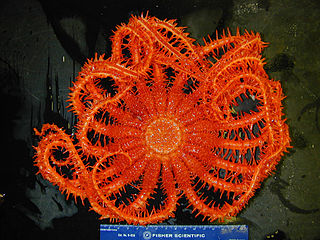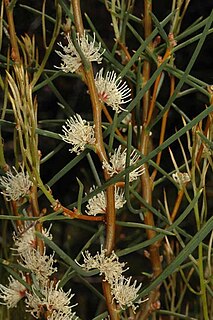
The Scorpaeniformes are a diverse order of ray-finned fish, including the lionfish, but have also been called the Scleroparei. It is one of the five largest orders of bony fishes by number of species, with over 1,320.

Malus is a genus of about 30–55 species of small deciduous trees or shrubs in the family Rosaceae, including the domesticated orchard apple – also known as the eating apple, cooking apple, or culinary apple. The other species are commonly known as crabapples, crab apples, crabtrees, or wild apples.

The haddock is a saltwater ray-finned fish from the family Gadidae, the true cods. It is the only species in the monotypic genus Melanogrammus. It is found in the North Atlantic Ocean and associated seas where it is an important species for fisheries, especially in northern Europe where it is marketed fresh, frozen and smoked; smoked varieties include the Finnan haddie and the Arbroath smokie.

Peter Christen Asbjørnsen was a Norwegian writer and scholar. He and Jørgen Engebretsen Moe were collectors of Norwegian folklore. They were so closely united in their lives' work that their folk tale collections are commonly mentioned only as "Asbjørnsen and Moe".

The Nilgiri langur is a langur found in the Nilgiri Hills of the Western Ghats in South India. Its range also includes Kodagu in Karnataka, Kodayar Hills in Tamil Nadu, and many other hilly areas in Kerala and Tamil Nadu. This primate has glossy black fur on its body and golden brown fur on its head. It is similar in size and long-tailed like the gray langurs. Females have a white patch of fur on the inner thigh. It typically lives in troops of nine to ten monkeys. Its diet consists of fruits, shoots and leaves. The species is classified as vulnerable due to habitat destruction and poaching for its fur and flesh, the latter believed to have aphrodisiac properties.

The school shark is a houndshark of the family Triakidae, and the only member of the genus Galeorhinus. Common names also include tope shark, snapper shark, and soupfin shark. It is found worldwide in temperate seas at depths down to about 800 m (2,600 ft). It can grow to nearly 2 m long. It feeds both in midwater and near the seabed, and its reproduction is ovoviviparous. This shark is caught in fisheries for its flesh, its fins, and its liver, which has a very high vitamin A content. The IUCN has classified this species as critically endangered in its Red List of Threatened Species.
Werneria is a genus of fairly small true toads found near fast-flowing steams in Middle and West Africa with the greatest species richness in the Western High Plateau of Cameroon. They are generally dark brownish or blackish and have a snout–to-vent length between 3 and 5 cm (1.2–2.0 in). The species generally have small distributions and are considered threatened.

Sternotherus is a genus of aquatic turtles, known commonly as musk turtles, in the family Kinosternidae. The genus is endemic to North America and is closely related to Kinosternon. The most common species of Sternotherus in most of North America is Sternotherus odoratus, the common musk turtle or stinkpot; that entry has more information on the ecology of this group of turtles.

Oenothera lindheimeri, formerly Gaura lindheimeri, and commonly known as Lindheimer's beeblossom, white gaura, pink gaura, Lindheimer's clockweed, and Indian feather, is a species of Oenothera.

The beira is a small arid adapted antelope that inhabits arid regions of the Horn of Africa.

Gymnothorax miliaris, the goldentail moray, bastard eel, yellow canary moray eel, or conger moray, is a species of marine fish in the family Muraenidae.

The Brisingids are deep-sea-dwelling starfish in the order Brisingida.

The Kimberley rock monitor is a medium-sized species of monitor lizard in the family Varanidae. The species is native to Northern Australia. Also known as Glauert's monitor or the Kakadu sand goanna, it belongs to the subgenus Odatria.

Hakea mitchellii, commonly known as desert hakea, is a shrub species in the family Proteaceae.

The Brisingidae are a family of starfish found only in the deep sea. They inhabit both the Atlantic and Pacific Oceans at abyssal depths, and also occur in the Southern Ocean and around Antarctica at slightly shallower depths.

Rhopilema verrilli, or mushroom cap jellyfish, is a species of jellyfish in the family Rhizostomatidae. They are cnidarian invertebrates distinguished by their mushroom-shaped medusae. The species does not have any tentacles; however, they still have stinging cells, called nematocysts, within their bells, which can produce mild stings to humans.
Brisinga is a genus of starfish in the family Brisingidae. The species in this genus are primarily found in deep sea habitats.
Vicia canescens is a species of legume in the vetch genus that is endemic to Lebanon.
Lissemys ceylonensis, the Sri Lankan flapshell turtle, is a freshwater species of turtle endemic to Sri Lanka.

Brisinga synaptoma is a species of starfish in the family Brisingidae, found in deep sea waters off the coast of New Zealand.



















